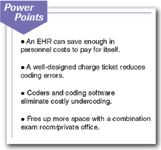Article
What are these doctors doing right?
They earn substantially more than their peers for some very good reasons.

Don't feel sorry for him, though-he's seeing plenty of patients. It's just that Gustafson didn't join the wave of doctors who went to work for area hospitals and health systems in the 1990s. Remember the siren song back then? You'd focus on medicine and let an MBA watch the dollars and cents? Gustafson and his six partners at the Kaukauna Clinic turned a deaf ear to that music and stuck it out on their own.
And they're glad they did. Gustafson's group is proof that doctors can run a small business successfully while retaining a zest for patient care. That's why we've profiled the Kaukauna Clinic and four other practices like it. They range from a solo shop in southern California to 11 internists in Michigan. All the doctors-excluding those they employ-earn anywhere from 14 to 60 percent more than the typical doctor in their specialty.
"It's a lot of little things that add up," says Max Reiboldt, a management consultant with The Coker Group in Roswell, GA. "There's not one silver bullet that makes one practice more profitable than another."
Spend a few minutes to learn more about William Gustafson and other "unemployed" physicians who are on top of their business game. You'll discover that the grass can be greener in the world of private practice.
Staffers who pay for themselves and more The Kaukauna Clinic demonstrates a principle that goes against today's lean-and-mean staffing ethos-you can never hire enough staff as long as they make you more productive. In addition to the usual medical assistant, each doctor has an RN or LPN, who spends lots of time on the phone talking to patients, labs, and other physicians coordinating care-jobs that the doctor might otherwise do, says Gustafson. "Most of us see 30 to 35 patients a day," he says. "If we didn't have a nurse, our productivity would be cut by one-fourth to one-third."
The clinic also employs two coders who work from the physician's dictation. Sure, the doctors could code themselves, but the full-time coders are more accurate, says Gustafson. "They attend coding conferences, and I don't." Greater accuracy means less undercoding-and less money left on the table-as well as cleaner claims, says business manager Kathy McNelly. Not surprisingly, their denial rate for insurance claims on the first submission is only 2.3 percent.
So while personnel costs may look high, they translate into higher revenue. All told, the group's overhead is 46 percent, well below the 60 percent for FPs in 2003 (see "Expense survey: What to spend, what to cut," in the Jan. 21 issue, available at http://www.memag.com/memag/article/articleDetail.jsp?id=143141). To be sure, the group tries to limit costs when it makes sense, saving money, for example, by purchasing refurbished lab equipment.





